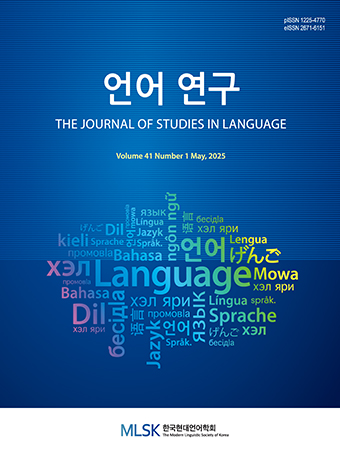Research Article
Abstract
References
Information
This study examines the use of discourse markers in English presentations by first-year university students in Korea. A total of forty-eight students made three-minute speeches about both education and social issues. Their speeches were analyzed regarding discourse marker types and the effects of speech topics and English proficiency. The results reveal that they rarely used discourse markers in their speeches and the frequently employed types were referential and structural markers. The education issue more familiar to them led to more use of discourse markers. In addition, the difference in English proficiency did not affect employing discourse markers. It is suggested that EFL learners’ pragmatic knowledge be improved through sufficient input and output of discours markers.
- 박광현, 김은주. 2019. 다차원 분석 활용 대학생 영어 학습자 프리젠테이션 연구: 정보 전달과 설득 프리젠테이션을 중심으로. 『외국어교육연구』 33, 1-26.
- 안수진. 2017. 한국인 영어 학습자들의 구어 및 문어담화에 나타난 응집장치 사용 양상. 『새한영어영문학』 59, 163-186. 10.25151/nkje.2017.59.2.009
- 원명옥. 2015. EFL 환경에서 구어발표를 통한 영어 발화의 유창성 향상 방안. 『언어과학연구』 75, 205-230.
- Aijmer, K. 2002. English Discourse Particles: Evidence from a Corpus. Amsterdam: John Benjamins. 10.1075/scl.10
- An, J. H. 2018. Analysis of the Discourse Marker Well in High School Practical English Conversation Textbooks. Modern English Education 19, 16-28. 10.18095/meeso.2018.19.1.02
- Blakemore, D. 1992. Understanding Utterances: An Introduction to Pragmatics. Oxford and Cambridge: Blackwell.
- Biber, D. 1988. Variation across Speech and Writing. Cambridge: Cambridge University Press. 10.1017/CBO9780511621024
- Celce-Murcia, M., and E. Olshtain. 2000. Discourse and context in language teaching. Cambridge, UK: Cambridge University Press.
- Chaudron, C. and J. Richards. 1986. The Effect of Discourse Markers on the Comprehension of Lectures. Applied Linguistics 7, 113-127.10.1093/applin/7.2.113
- Cho, H. Y. 2014. Cohesive Devices in English Writing Textbooks and Korean Learners’ English Writings. English Teaching 69, 41-59. 10.15858/engtea.69.1.201403.41
- Comfort, J. 1995. Effective Presentations. Oxford: Oxford University Press.
- Dale, P. and J. Wolf. 2000. Speech Communication Made Simple. While Plains, NY: Longman.
- Fraser, B. 1999. What Are Discourse Markers? Journal of Pragmatics 31, 931-952.10.1016/S0378-2166(98)00101-5
- Ferris, D. and T. Tagg. 1996. Academic Oral Communication Needs of EAP Learners: What Subject Matter Instructors Actually Require. TESOL Quarterly 30, 31-58. 10.2307/3587606
- Fung, L. and R. Carter. 2007. Discourse Markers and Spoken English: Native and Learner Use in Pedagogic Settings. Applied Linguistics 28, 410-439. 10.1093/applin/amm030
- Haliday, M. and R. Hasan. 1976. Cohesion in English. London: Longman.
- Hellermann, J. and A. Vergun. 2007. Language Which Is Not Taught: The Discourse Marker Use of Beginning Adult Learners of English. Journal of Pragmatics 39, 157-179. 10.1016/j.pragma.2006.04.008
- Kim, M. H. 2004. Korean EFL Learners’ Use of Conjunctions in Spoken Narratives. Studies in Modern Grammar 37, 219-238.
- Ko, H. S. 2013. Overuse of the Discourse Filler, “so” in Micro-teaching Talks by Koreans. Language Research 49, 25-44.
- Műller, S. 2005. Discourse Markers in Native and Non-native English Discourse. Amsterdam/Philadelphia: John Benjamins.10.1075/pbns.138
- Na, Y. H. 2011. Cohesive Devices in CMC Texts Produced by American and Korean EFL Writers. Linguistic Research 28, 743-771. 10.17250/khisli.28.3.201112.014
- Quinn, J. E. 2011. Discourse Markers in the University Classroom. Unpublished MA thesis, CA: San Diego State University.
- Rahimi, M. 2011. Discourse Markers in Argumentative and Expository Writing of Iranian EFL Learners. World Journal of English Language 1, 68-78. 10.5430/wjel.v1n2p68
- Redeker, G. 1990. Identical and Pragmatic Markers of Discourse Structure. Journal of Pragmatics 14, 367-381. 10.1016/0378-2166(90)90095-U
- Ryoo, H. K. 2016. Cohesion and Coherence in Korean EFL Learners’ Spoken Discourse. The Journal of Linguistics Science 79, 95-115.10.21296/jls.2016.12.79.95
- Soh, Y. H. 2003. Student’s Preparation, Perception and Attitudes Toward an Oral Class Presentation. English Teaching 58, 69-94.
- White, A. 2014. Discourse Markers in Task Interaction: A Comparison between Korean EFL Learners and Native Speakers. Modern English Education 15, 1-22.
- Publisher :The Modern Linguistic Society of Korea
- Publisher(Ko) :한국현대언어학회
- Journal Title :The Journal of Studies in Language
- Journal Title(Ko) :언어연구
- Volume : 37
- No :1
- Pages :21-35
- DOI :https://doi.org/10.18627/jslg.37.1.202105.21




 The Journal of Studies in Language
The Journal of Studies in Language






